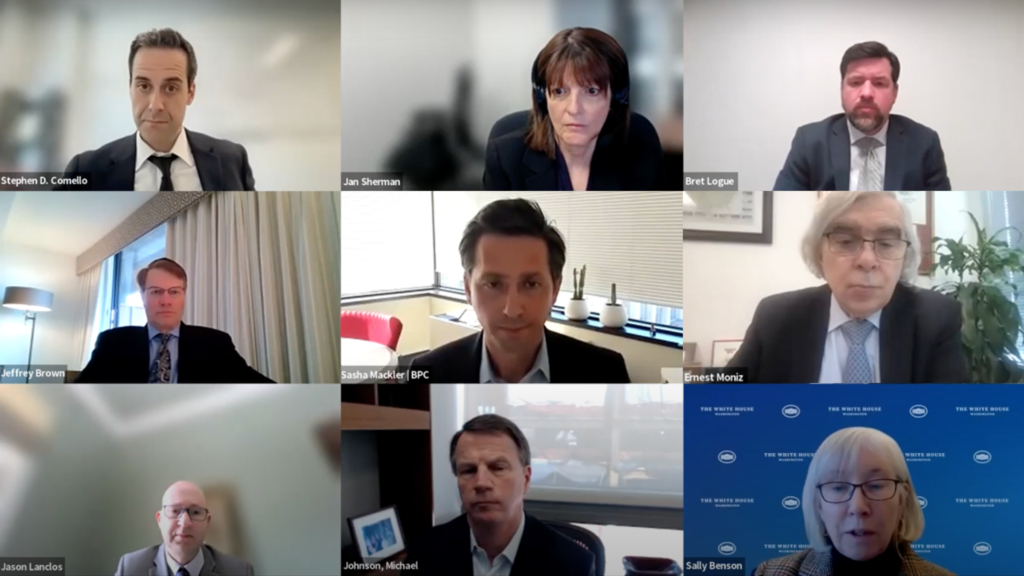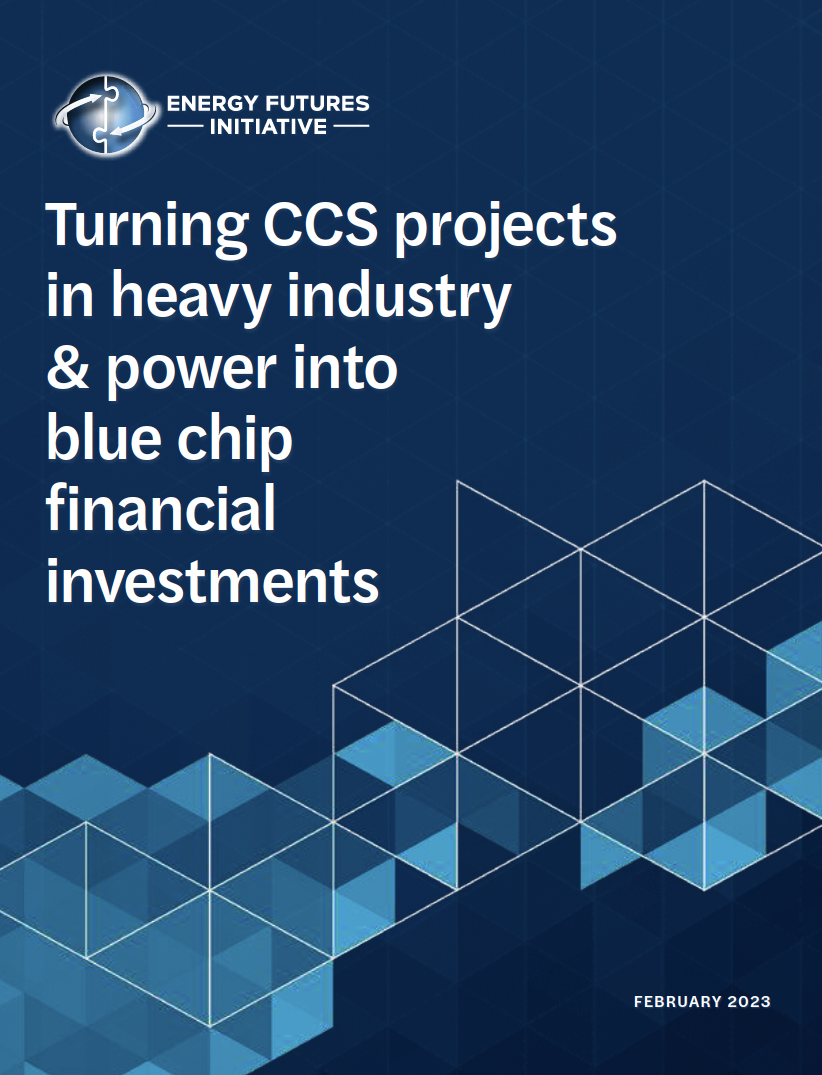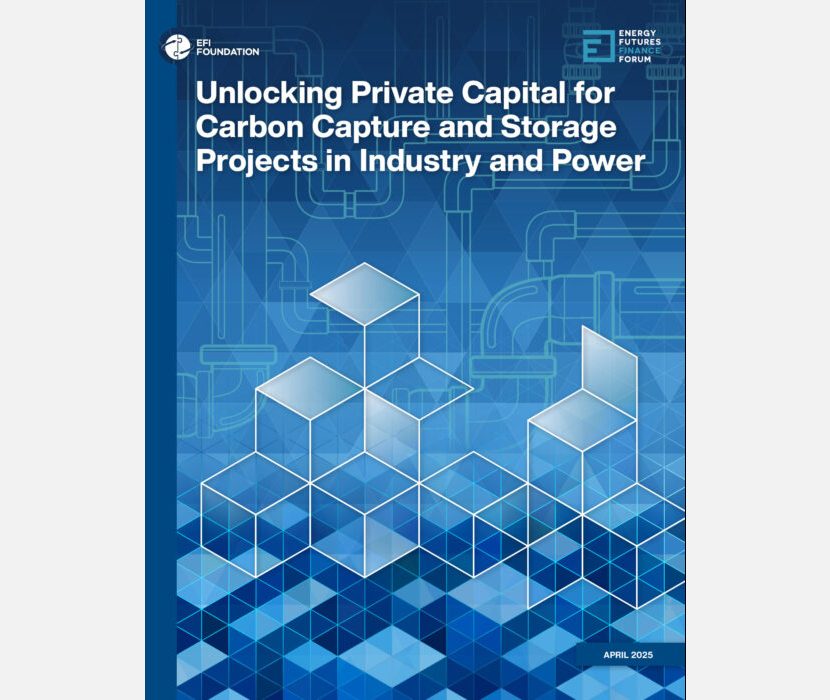
Carbon capture and sequestration (CCS) has the potential to mitigate several hundred metric tons of carbon dioxide (CO2) emissions per year. However, progress toward commercial-scale deployment of CCS for decarbonization is slow moving because the private sector is hesitant to invest in CCS while stark challenges persist.
So, what will make investors say “yes!” to allocating capital to CCS projects? The latest Energy Futures Initiative (EFI) report—Turning CCS Projects in Heavy Industry and Power into Blue Chip Financial Investments—describes the challenges that investors, project developers, and project owners face when considering CCS. It provides targeted policy actions to overcome these investment barriers to ensure CCS reaches its potential as a pollution control mechanism. EFI introduced the report on February 14, 2023, during a public webinar that featured a range of stakeholders in the CCS space.
“We simply need to…address the bankability, or investment quality, issue for decarbonization solutions because the existing pools of capital really are not yet fully engaged,” EFI CEO Ernest Moniz explained. “One such decarbonization solution that certainly has bankability challenges is CCS.”
Setting the CCS scene: A mature technology for new use
The components that comprise CCS are not new technologies. As our report explains, carbon capture has been commercially deployed for decades in natural gas processing, urea production, and petrochemical production from coal gasification. CO2 is routinely transported via pipelines, and it has been injected into geologic formations for decades for enhanced oil recovery purposes. However, deploying these technologies for the purposes of pollution control (to curb CO2 emissions), is a novel application that could transform it into a decarbonization solution.
Sally Benson, deputy director for energy and chief strategist for the energy transition at the White House Office of Science and Technology Policy (OSTP), underscored the current state of CCS in her keynote remarks.
“Nearly three decades ago, the first purpose-built CCS project was established [off the coast of Norway] with the intention of avoiding putting greenhouse gases into the atmosphere,” Benson said. “More than 20 million tons of CO2 have been captured and stored… [and] about 30 CCS facilities are keeping about 42 million tons of CO2 from being emitted into the atmosphere.”
Benson further contextualized the need and potential of CCS from an administration perspective. Drawing on an OSTP report from 2022, she stated that all scenarios for meeting U.S. net-zero goals by 2050 require CCS, accounting for perhaps as much as 10% to 30% of today’s U.S. greenhouse gas emissions. Benson described CCS as a “transformational technology” because it is both necessary and versatile in its application across many industries.
Yet, Moniz pointed out that CCS’s potential for decarbonization has yet to be fully realized. “Despite the capabilities, CCS progress to date in the United States… [has] been a little bit disappointing in its pace,” Moniz said.
Moniz and Benson agreed that the Inflation Reduction Act (IRA) and Bipartisan Infrastructure Law (BIL) signal very strong policy support for CCS. For example, the IRA increased the 45Q tax credit’s value to $85/metric ton for CCS with geologic sequestration, expanded eligibility requirements, and added transferability and direct pay provisions.
While recent legislation is likely to improve CCS’s investment quality by offsetting costs, our report highlights the need for additional policy action to decarbonize heavy industry and the power sector using CCS.
Contributing to the CCS conversation: Report findings and recommendations
EFI’s new report is distinct from others about CCS because it focuses on the factors that influence financing decisions of a project, EFI Foundation Managing Director Jeffrey Brown explained during the webinar.
Brown reiterated that without carbon pricing, the only incentives for CCS are government grants, loans, and tax credits, making it policy dependent. The report shows that while the IRA makes significant gains for CCS, recent inflation has minimized them.
“[The] increase in capital goods price, higher gas, higher electric, and higher interest rates… ate up a big portion of the increase from $50 to $85 [brought by the IRA],” Brown said.
Beyond policy dependence, application heterogeneity and value chain complexity are root causes that inhibit CCS from rapidly scaling. Moniz described how application heterogeneity arises because each new application of CCS is first-of-a-kind, which increases risk and decreases investor confidence. Value chain complexity stems from the reality that all four links in the CCS value chain—capture, transport, deep underground injection, and ongoing monitoring—require integration and coordination.
These issues form the basis of six areas (themes) of investment challenges that prevent high-quality investment in CCS. Brown focused on these challenges and described the policy recommendations to overcome them, as outlined in EFI’s report. For example, to increase supply and demand incentives for CCS, the U.S. Department of Energy should provide low-cost equity in the form of grants—alongside the IRA tax credit—to the first five projects in an industry. Congress should enable DOE to issue loans to first-of-a-kind projects that are already grant recipients. Likewise, states should make CCS an eligible compliance solution by modifying their clean electricity procurement standards. Following these recommendations would minimize investment challenges and help get investors to say “yes!” to CCS.
Hearing the perspective of CCS stakeholders
The webinar reflected the report’s focus on the concerns of investors, project developers, and project owners. It also featured stakeholders across the CCS sphere: Sasha Mackler (Bipartisan Policy Center), Jan Sherman (Carbonvert), Bret Logue (Elysian), Jason Lanclos (Louisiana Department of Natural Resources), and Michael Johnson (J.P. Morgan). The panel discussion narrowed in on the factors that are necessary to stimulate high-quality—or what is often known as “blue chip”—investment in CCS.
“We have a well understood set of [CCS] technologies, for the most part, but not well understood [are] the business models and investment framework,” stated Mackler, executive director of the energy program at the Bipartisan Policy Center.
Approaching CCS from a project developer’s perspective, both Sherman (chief development officer at Carbonvert) and Logue (CEO of Elysian) said they are focused on creating financeable CCS projects.
Logue pointed to the problem of application heterogeneity as it pertains to CCS projects. “While there is the proverbial low-hanging fruit, in terms of ethanol plants and natural gas processing…there are quite a lot of other spaces…which are much more challenging to get to,” he said.
Sherman explained that project developers are also encountering issues with value chain complexity. “We [at Carbonvert] found that every step in the value chain is new right now, both technically and commercially,” Sherman said. “Overall, we’re facing first-of-a-kind inefficiencies in permitting the storage sites and pipelines…acquiring the pore space, and managing long-term site care, among many others.”
Sherman called for state and federal policymakers to urgently create regulations and processes for CCS that are clear and effective.
Lanclos, the director of the state energy office at the Louisiana Department of Natural Resources, offered a state perspective on CCS challenges.
“The thing we hear time and time again [from nongovernmental organizations and investors] is that they need certainty on regulatory pathways and also how this process is going to work in the long term,” he said.
Lanclos added that Louisiana has worked diligently to create a robust program that addresses the regulatory and long-term liability transferring concerns of CCS.
Taking an investment perspective, Johnson (vice chairman of energy, power, and renewables investment banking at J.P. Morgan) explained that investors do not see CCS as the mature and well-established technology it is. Instead, they see it as having many upfront risks.
“We’ve got to convince them it’s investable,” Johnson said.
He talked about how doing so has been successful, highlighting how investors are passionate about CCS as a necessary and economically attractive decarbonization solution. Despite the investment challenges, Johnson reiterated his enthusiasm for CCS.
Moniz said when it comes to scaling the development of CCS for decarbonization, “it’s about finishing the job.”
— Jaycee Scanlon, Communications Fellow
Related Content
(Share this post with others.)






